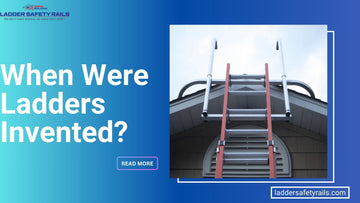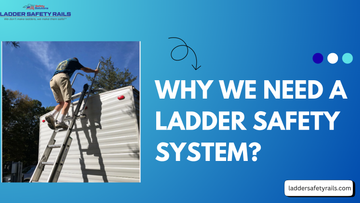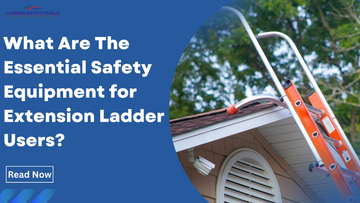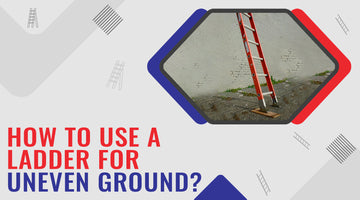
Using a ladder on uneven ground can be dangerous if you don't know what you're doing or how to do it correctly. Unstable ground or footing can lead to the ladder shifting, tipping, or even collapsing, putting you at serious risk of injury.
<As a leading provider of ladder safety solutions, we at Ladder Safety Rails know just how important it is to use the proper techniques when working on uneven surfaces.
This blog will provide answers to all your unanswered questions related to ladder safety on uneven ground. From selecting the right type of ladder to properly securing it in place, to ensuring using a stable and secure ladder on uneven ground.
How to Use a Ladder on Soft Ground:
When it comes to using a ladder on soft or uneven ground, the first and most important step is to establish a stable base. Soft soils, such as sand, mud, or loose dirt, can cause a ladder to sink, shift, or even tip over, putting you at serious risk. Provided below are a few tips that you must take into account next time you use a ladder on uneven ground.
-
Use a Stabilizer:
Consider investing in a ladder stabilizer, such as those offered by Ladder Safety. These extend the ladder's footprint thereby distributing the weight more evenly and preventing sinking. Additionally, they can be purchased as add-ons or may come pre-installed on some ladder models.
-
Create a Stable Base:
If a stabilizer isn't available, you can create a stable base by placing a piece of plywood or a sturdy board under the ladder's feet. The key here is to choose a material that won't sink or shift under the ladder's weight.
-
Check Stability:
Before climbing the ladder, always check for stability. Try shaking the ladder gently to ensure it's firmly planted on the ground. If it feels unstable, readjust the base or relocate to a more stable surface.
How to Use a Ladder on Hard Ground
Using a ladder on hard, uneven surfaces, such as rocky terrain or compacted soil, presents a different set of challenges compared to soft ground. While the risk of sinking may be lower, the potential for the ladder to shift or become unstable is still a significant concern.
-
Ladder Adjustable Legs:
Many ladders with adjustable legs for stairs can be extended to accommodate uneven surfaces. Adjust these legs until the ladder is level and stable.
-
Use a Level:
If you're unsure whether the ground is level, use a spirit level to check. Ladder with sturdy, wide-set feet is often the best option. These ladders are designed to withstand greater weight and pressure, making them more suitable for the demanding conditions.
-
Proper Positioning:
Ensure that the feet are positioned on the most level and stable areas of the ground, avoiding any cracks, holes, or protruding rocks. Use the ladder's leveling feet, if available, to further adjust the stability and alignment. -
Secure the Top:
In addition to stabilizing the base, it's essential to secure the top of the ladder to prevent it from slipping sideways. Use ladder stabilizers or tie-offs to anchor the ladder securely.
Tips for Safely Using Ladder Extension on Uneven Ground
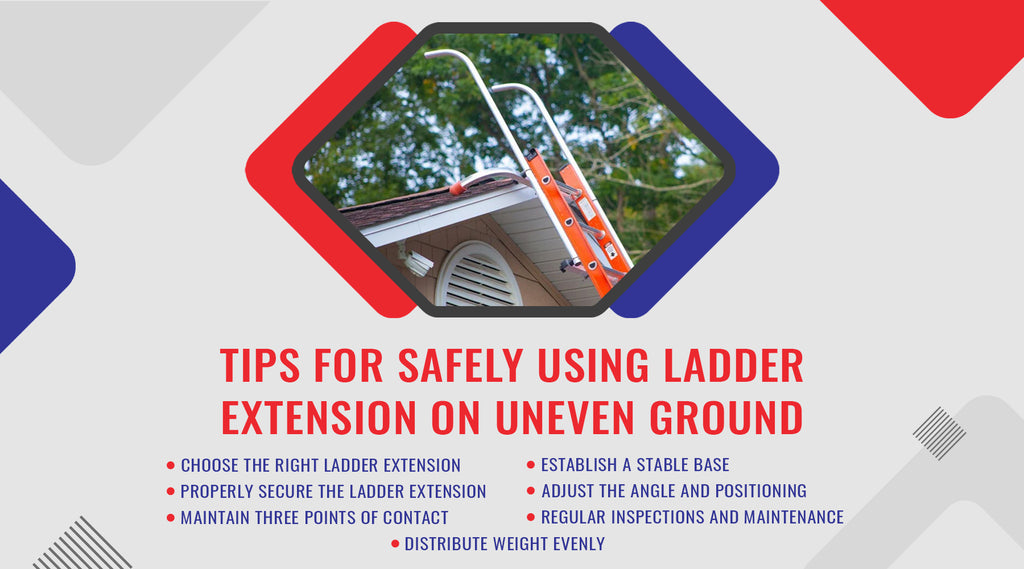
When working on uneven ground, using a ladder extension can provide added reach and accessibility. However, it's crucial to take extra precautions to ensure the stability and safety of the setup. Here are some key tips to keep in mind for using ladder for uneven surfaces:
-
Choose the Right Ladder Extension
Pick a heavy-duty, industrial-grade ladder extension designed to handle the uneven terrain. When purchasing, look for features like wider feet, adjustable leveling mechanisms, and sturdy, non-slip materials.
-
Establish a Stable Base
Use ladder stabilizers or improvised platforms to create a level and secure base for the ladder. Make sure that the base is large enough to accommodate the extended reach of the ladder.
-
Properly Secure the Ladder Extension
Carefully follow the manufacturer's instructions for attaching the extension to the base ladder. Use all the recommended safety locks, braces, and other securing mechanisms to prevent the extension from shifting or separating.(Extra precautionary step)
-
Adjust the Angle and Positioning:
Set the ladder at the proper angle, typically 75-80 degrees, to ensure maximum stability and weight distribution. Adjust the leveling feet or stabilizing materials to compensate for any unevenness in the ground.
-
Distribute Weight Evenly:
Avoid concentrating too much weight on one side of the ladder, because this can lead to tipping or instability. Instead center your body and balance your weight as you climb.
-
Maintain Three Points of Contact:
Pro tip: When climbing or using the ladder, always keep three points of contact (two hands and one foot, or two feet and one hand). You can remain balanced and safe in this manner even over difficult terrain.
-
Regular Inspections and Maintenance:
Thoroughly inspect the ladder and extension before each use. You can also follow the manufacturer's recommended maintenance and cleaning procedures to ensure optimal performance and safety.
Conclusion
Using a ladder on uneven ground requires special attention and care to make sure it is safe. Whether you're working on soft, sandy soil or hard, rocky terrain, the key is to establish a stable and secure foundation for the ladder.
We at Ladder Safety Rails are committed to providing you with the knowledge, tools, and support you need to work safely and effectively. So, the next time you find yourself facing an uneven work surface, remember the tips and techniques outlined in this guide to ensure safety on ladders.
FAQs
Yes, you can use a ladder on an uneven surface, but it's essential to take precautions to ensure stability and safety.
Ladder stabilizers or a solid board placed beneath the ladder's foot to provide a secure base are two ways to support a ladder on soft ground.
A ladder's safe slope is commonly thought to be a 4:1 ratio, which states that the ladder's base should be one foot away from the wall or other surface it is leaning against for every four feet of height.
Before climbing, make sure the ladder is level, solid, and firmly in place according to ladder positioning guidelines. Always abide by the instructions provided by the manufacturer, and where needed, take additional safety precautions such as tie-offs or stabilizers.
Read More Blogs Here:



